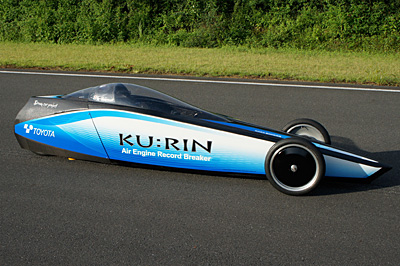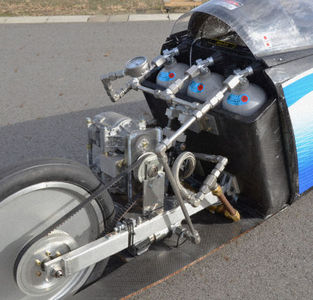KU:RIN Grabs Compressed Air Car Record of 129.2 KM/H
Like its chunky cousin, the MDI Air Car, the sleek KU:RIN is also unlikely to see production. But that does not mean that we should not be impressed: This little pencil-shaped rocket (3.5m long, but just 0.8m wide) broke the speed record for compressed air-powered vehicles at the Japan Automobile Research Institute (JARI) test facility at Shirosato, Ibaraki Prefecture on September 9th. That’s right, 80.3 MPH running on compressed air alone.
The KU:RIN was designed and built by the 40 members of the “Dream Car Workshop” (yume no kobo) club at Toyota group company Toyota Industries Corporation that was started in December 2006. It is no coincidence that Toyota Industries Corp happens to be the biggest supplier of car air conditioner compressors in the world – to the tune of 20 million every year. So these guys know something about compressed air.
To power the KU:RIN, these developers reversed an air conditioning compressor so that instead of using mechanical power to compress air, instead it generates mechanical energy from the expansion of the compressed air. The compressed air is not fuel as such, but it acts as energy storage fulfilling much the same role as a battery pack in an electric car.
The thing is, if you get range anxiety every time you think of buying an electric car, then you will really be chewing your finger nails down when you hear how far the KU:RIN can go between “charges” (what is the right word for an air-powered car?): Not 320KM. Not 32KM. Just 3.2 KM. So just enough to get up to that top speed and then…. run out of power.
The development team is submitting their result to Guinness World Records.
Trivia: The name KU:RIN is likely derived from the Japanese kanji for “air” (ku) and “wheel” (rin).
UPDATE:
Watch a video of the KU:RIN in action in this (Japanese) NHK news report or below:
httpvh://www.youtube.com/watch?v=ospqdAXVlWo
Sources: Toyota Industries Corporation (Japanese), 20Min.ch (French)





Good job done. But range may be increased 2 ways by improving aerodynamics.(1)Cover the 2 open wheels by fxting them in widest portion and single wheel at tail end.Operator position be like that in hang glider(2) Direction of the vehicle motion should be reversed to decrease drag to get perfect raindrop shape while in motion.
Excellent ideas, Vasant. I suspect these guys are going to keep on developing their dream machine, so keep an eye out for KU:RIN2 and see if they have incorporated any of these suggestions.
It seems that KU:RIN creator’s intention is to make speed record, rather than to enhance range.In addition to our earlier 2 suggestions( see response no.3),here we add 3 more, which also are to raise it’s speed and range both: (3)Use higher power to weight ratio bearer air motors like QuasiTurbine(QT) or EngineAir’s Di Pietro Motor(DPM),replacing the reversed airconditioner Compressor.( See related links: www. quasiturbine .com and www. engineair. com. au:) (4)Incorporate the round disc shaped QT/DPM in the third (single) wheel.Pressurised air may be injected in QT or DPM through hub and Air exhaust be released backwards.QT OR DPM may be accomodated among wheel rim in such a way that it becomes wheel hub and shares common axle with the wheel. Now the weight of air motor will be applied directly on wheel and not on chassis.Now as per automobile rule, 1 kg of weight reduction on chassis,results in 5 kg of reduction on overall weight.So air motor shifted from chassis to wheel, will yield many times more overall weight reduction benefit. (5)Compressed air tank made of carbon fiber composite be kept in front.Air from tank be passed through multiple Cu /Al /Mg tubes and provided to the tail wheel hub through flexible rubber tube connections.Open hot air from black asphalt road be allowed to pass through parallel cold tubes. If external combustion is not allowed, heat energy can be added thus, will result in increase of air pressure and system efficiency,which finally will result in higher speed of the KU:RIN.
You guys clearly know your stuff.
Concerning the engine, using a specialist motor would certainly help, but I wonder whether part of this is a PR exercise with these guys using the reversed AC compressor produced by their parent company.
hi this is awasome vasant.